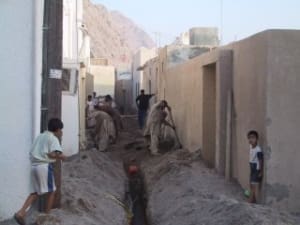The Hidden Costs of Gravity Sewers versus Vacuum Sewers
When looking at what sewage infrastructure to use in a difficult area, most consultants will do a study which compares gravity sewers with vacuum sewer technology. In some smaller communities they may also do a comparison showing a low pressure or grinder pump system.
These costs are usually split between the Capital Cost of the Project and the Whole of Life costs. In some countries the consultant will also do a carbon footprint study to look at the environmental impact of the new infrastructure.
When looking at the Capital Cost for a sewerage infrastructure project engineers look at the following major items.
- Pump Station Costs
- Cost of Pipe in the Ground
- Manholes or collection Pits
- Property Connection costs to the Collection point
- Rising Main Cost to the Treatment Plant
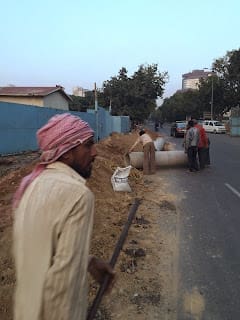 Will this information give a municipality or developer the full picture? What is being left off this analysis?
Will this information give a municipality or developer the full picture? What is being left off this analysis?
Pump Station Costs – In a gravity system, multiple gravity pump stations may be required (up to 18) where one vacuum station will handle the flow. Is the cost of the land taken into account? How about the impact of a properties value if situated next to a gravity station?
Pipe Installation Cost – Usually the consultant will look at the price of pipe per metre installed in the ground, but how about how long the construction period is to install pipe in difficult ground where dewatering may be required. The gravity project in the photo required 2 weeks per every 100 metres of pipe being laid. Some area’s with very hard rock may take longer. If dewatering what is the cost of disposing of the water? If requiring new fill from somewhere else to embed the pipe, what is that cost?
Impact on Community, Trade and House Sales. – If a project takes a long time to be installed then a municipality may not allow a developer to commence the sale of houses until all houses are connected to the sewer. If commercial area’s or shops cannot be accessed for extended periods this may have a financial impact on the project. If homeowners cannot access their homes then what is the political cost?
Easement Requirements – When looking at a low pressure pump scheme where pumps are required on private properties has the cost of an easement been built into the estimate? When looking at Whole of Life costs does it include washing down the sewage off people’s yards after repairs have been made to the pumps?
Treatment Plant Impact – If designing a gravity sewer where infiltration will need to be accommodated will the Treatment Plant need to be upgraded and what is the impact of the increased discharge?
 Operational Costs and Risks. – Health and Safety of operators, Odour, gas explosions, fatbergs, wet wipes clogging pumps, exfiltration damage. None of these are adequately covered in assessments.
Operational Costs and Risks. – Health and Safety of operators, Odour, gas explosions, fatbergs, wet wipes clogging pumps, exfiltration damage. None of these are adequately covered in assessments.
Energy Costs – Does the community count the cost of the extra energy costs when it is only homeowners paying the cost with grinder pumps or do you need to look at the cost to the town. When infiltration occurs how much extra power will that consume at pump stations and at the treatment plant.
 Increased Risk – is there an assessment given over possible EPA or environmental fines if a gravity system or low pressure system discharges sewerage into a sensitive area. What happens in a tourism area if the sewage overflows? How about in a fishery habitat?
Increased Risk – is there an assessment given over possible EPA or environmental fines if a gravity system or low pressure system discharges sewerage into a sensitive area. What happens in a tourism area if the sewage overflows? How about in a fishery habitat?
There are many other hidden costs and many more long term costs to be taken into account, This is especially true when trying to repair a leak in a pipe 10 metres (30′) under the highway. I am sure you can think of other costs that have impacted on projects you have done in the past, If so, we would love to hear about your experiences.

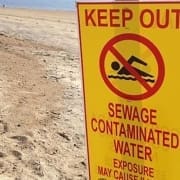


 Vacuum valves are opened by the difference in air pressure automatically and take in the wastewater from pits. No electricity at the pips is required. The pressure differential allows sewage to flow into the vacuum station and then it is pumped to the Treatment Plant.
Vacuum valves are opened by the difference in air pressure automatically and take in the wastewater from pits. No electricity at the pips is required. The pressure differential allows sewage to flow into the vacuum station and then it is pumped to the Treatment Plant.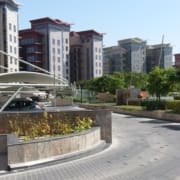


 Merko, the leading construction company in Estonia has finished construction in Vääna-Jõesuu of Estonia’s second vacuum sewerage system – Flovac’s first system was completed last year in Leppneeme and has performed better than expectations for both the community and the operators.
Merko, the leading construction company in Estonia has finished construction in Vääna-Jõesuu of Estonia’s second vacuum sewerage system – Flovac’s first system was completed last year in Leppneeme and has performed better than expectations for both the community and the operators.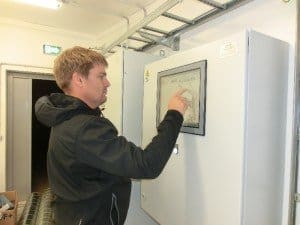 “A vacuum station and waste water pumping station were built in the Puraviku tee and Nõmmerohu tee area, as well as 3.8 km of drinking water piping and 4.1 km of sewerage piping, including nearly 3.6 km of vacuum sewerage piping. The benefit of vacuum sewerage is efficiency – the sewerage pumping station does not have to pump excess water, since the watertight vacuum sewerage system takes in significantly less water from rainfall, snowmelt, leaking pipes and wells than ordinary sewerage systems. The vacuum sewerage tanks are waterproof and the tanks’ lids are 10-20 cm above the ground to prevent rainwater from leaking in from the lid,” Laidma explained.
“A vacuum station and waste water pumping station were built in the Puraviku tee and Nõmmerohu tee area, as well as 3.8 km of drinking water piping and 4.1 km of sewerage piping, including nearly 3.6 km of vacuum sewerage piping. The benefit of vacuum sewerage is efficiency – the sewerage pumping station does not have to pump excess water, since the watertight vacuum sewerage system takes in significantly less water from rainfall, snowmelt, leaking pipes and wells than ordinary sewerage systems. The vacuum sewerage tanks are waterproof and the tanks’ lids are 10-20 cm above the ground to prevent rainwater from leaking in from the lid,” Laidma explained.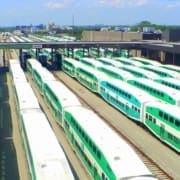
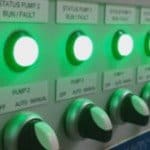 As trains come into the yard maintenance crews can hook up a vacuum hose via a fitting to the trains sewage holding tanks. The tank is evacuated via a push button control on the Flovac Valve. Sewage goes via a vacuum main back to a series of vacuum pumps and then discharged to the gravity network.
As trains come into the yard maintenance crews can hook up a vacuum hose via a fitting to the trains sewage holding tanks. The tank is evacuated via a push button control on the Flovac Valve. Sewage goes via a vacuum main back to a series of vacuum pumps and then discharged to the gravity network. The management team and operators at Willowbrook were particularly impressed with the speed of the evacuation of the trains as the process took a matter of seconds rather than the extensive delays that they have previously had. This meant that money was saved in labour costs but more importantly in the amount of time that it took to get the trains back into service.
The management team and operators at Willowbrook were particularly impressed with the speed of the evacuation of the trains as the process took a matter of seconds rather than the extensive delays that they have previously had. This meant that money was saved in labour costs but more importantly in the amount of time that it took to get the trains back into service.

